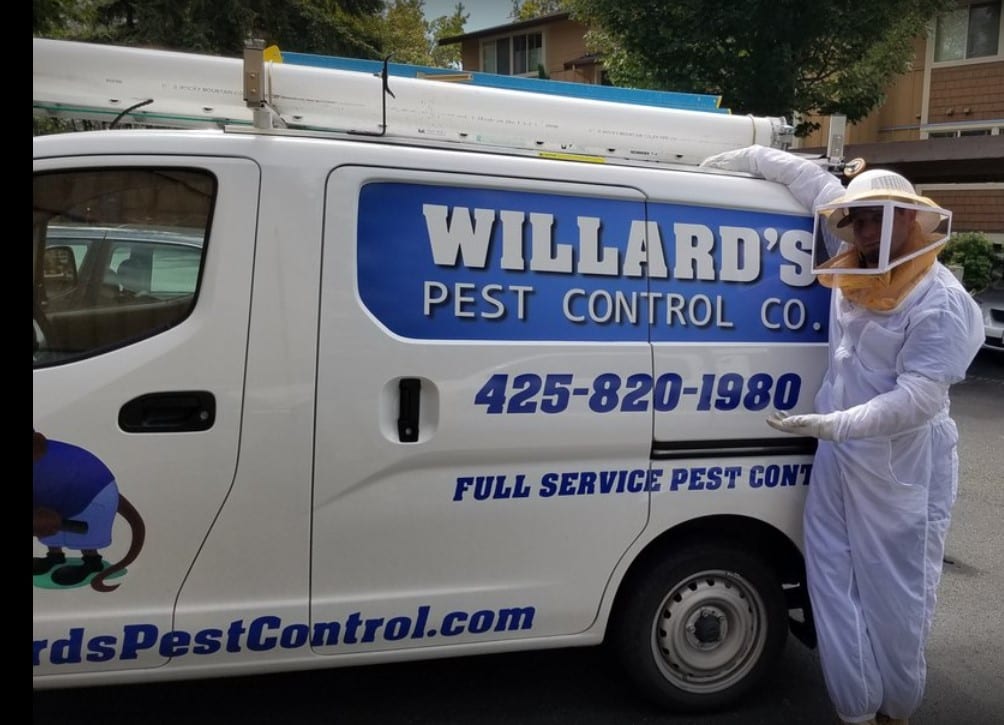
It’s a perfect late August day in Western Washington. You’re enjoying a picnic at Golden Gardens or hosting a backyard barbecue in Bellevue when the uninvited guests arrive. First one, then another, until a persistent, aggressive wasp is buzzing your soda can or landing on your hamburger. It’s a familiar feeling that leads to the same thought every year: “It feels like they’re everywhere and angrier than ever!”
Is it just your imagination, or is there a scientific reason wasps become such a nuisance from August through October?
The answer is yes—there are clear biological reasons for this dramatic shift in wasp behavior and population. As the local experts, Willard’s Pest Control is here to explain what’s happening in your backyard.
Key Takeaways for Seattle Homeowners:
- Peak Population: Wasp colonies reach their maximum size of 1,000-4,000 workers in late summer.
- Food Crisis: Their natural food sources decline, making them desperate scavengers for your food and drinks.
- Increased Aggression: They become fiercely protective of the new queens in the nest, leading to a lower tolerance for threats.
The Wasp Colony Lifecycle: A Tale of Two Seasons
The entire lifecycle of a wasp colony begins with a single, overwintering queen. In the spring, as temperatures rise, this lone queen emerges from her shelter and gets to work. She builds a small nest, often no bigger than a golf ball, and lays her first batch of eggs. During this phase, from roughly April to June, the colony is small and the wasps are rarely noticed by homeowners.
By July and August, the situation has changed dramatically. The nest has grown exponentially as the initial workers have matured and taken over all foraging and nest-building duties. This frees up the queen to do one thing: lay eggs.
This population explosion is the core reason you see so many more wasps. A mature yellow jacket nest in Western Washington can contain 1,000 to 4,000 workers by late summer. What was once a small, hidden nest is now a bustling city of thousands, all demanding food.
The Perfect Storm: 3 Reasons for Late-Summer Aggression
The second reason for the increased aggression is a colony-wide food crisis. Throughout the early summer, workers hunt caterpillars, flies, and other insects to feed the protein-hungry larvae in the nest. In return, the larvae produce a sugary secretion that the adult workers feed on.
In late summer, this system breaks down, creating the perfect storm for aggressive behavior:
- Protein Shortage: The wasps’ natural insect prey begins to decline in population.
- Sugar Craving: The queen slows down and eventually stops laying eggs. With no new larvae, the workers’ internal sugar source dries up.
- Defensive Overdrive: The colony’s final mission is to protect its final brood: new queens and males who will mate. The workers become fiercely protective of the nest and these future queens. Their defensive perimeter expands, and their tolerance for intruders plummets. An activity as simple as mowing the lawn near a ground nest or walking too close to a shrub containing a nest can trigger a massive, painful defensive swarm.
The result is thousands of hungry, desperate, and highly defensive workers. They become aggressive scavengers, turning their attention to the sugary and protein-rich foods at your outdoor gathering. That’s why they are so persistent about your soda, beer, fruit, and grilled meats.
Who Are the Main Offenders in Western Washington?
While there are many species of wasps, two are primarily responsible for ruining late-summer fun:
- Yellow Jackets: The number one pest at any outdoor meal, known for their aggressive scavenging.
- Bald-Faced Hornets: Extremely defensive of their large, aerial nests and will attack any perceived threat in large numbers.
How to Protect Your Family During Peak Wasp Season
You can make your yard less attractive to these desperate pests with a few simple steps:
- Keep all trash and recycling bins securely covered.
- Never leave sugary drinks, fruit, or other food unattended outdoors. Use cups with lids when possible.
- Before doing yard work, take a moment to look for signs of a nest under eaves, in dense shrubs, or on the ground.
- Avoid swatting at a single wasp. If you crush it, it can release an alarm pheromone that attracts other wasps from the colony. It’s better to calmly walk away.
Frequently Asked Questions
- Why are wasps so bad in August and September in Seattle? This is when their colonies are at their largest size, their natural food is scarce, and they are desperately seeking sugar and protein while aggressively defending the nest’s new queens.
- Will wasps go away on their own? Yes, the entire colony (except for the new, mated queens who leave to hibernate) will die off after the first few hard frosts. However, a nest near your home poses a significant stinging risk until then.
- What’s the difference between a wasp and a hornet in Washington? In our area, the main “hornet” people encounter is the Bald-Faced Hornet, which is technically a large species of yellow jacket wasp. True hornets, like the Northern Giant Hornet, are not established in the Seattle area.
Conclusion: It’s Not Your Imagination, It’s Biology
If you feel like wasps get worse every year in late summer, you’re right. The combination of a peak population, a desperate food crisis, and the instinct to protect new queens creates the perfect storm for aggressive behavior.
If you are seeing a constant stream of wasps entering or exiting a single point on your property, or if you have located a nest, don’t wait for the problem to escalate. Contact the experts at Willard’s Pest Control for safe and immediate removal. We’ll help you take back your late-summer enjoyment.


